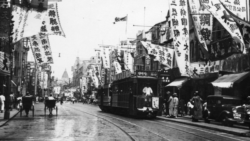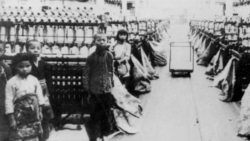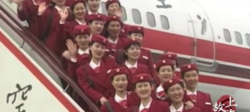Shanghai Female Textile Workers, China's first female working class
Shanghai was first recognized as a city in 1291, during the Yuan Dynasty (Wasserstrom 2008) when neighbouring villages were amalgamated to form a new Shanghai County, creating a settlement with a population of around 300,000 people, mostly working in shipping. The following centuries saw little change as the population of Shanghai in 1881 was estimated at a mere 302,000 people.

Image - 'Virtual Shanghai'
The western presence in Shanghai saw an increase in the population as servants and staff were required to maintain the westerners lavish lifestyles and in 1895 the population had risen to 411,000. However, at this time the first of the new textile factories were being constructed and a workforce was required. Over the following five years the population more than doubled as it rose to 1m by 1900.
The workforce for the new textile industry were predominantly male migrants from the neighbouring regions of Jiangsu and Zhejiang provinces, geographically separated as the North (Jiangsu) and South (Zhejiang) of the Yangzi River and, following the lead from UK Industrial Revolution practices to utilise cheap labour, children were employed in the early mills.

'Virtual Shanghai'
Initially, there were few female labourers, as many Chinese women had traditional bound feet, making them unsuitable for mill work that required workers to stand for lengthy periods of time. Further to this it was considered ‘unlucky’ for females to take factory work (Fung 1948). Two political-socio-economic events were to alter this behavior.
Humiliating defeats in the Opium Wars and Sino-Japanese conflicts had caused the Chinese to examine themselves. Centuries of stasis, following an ancient Confucian Doctrine, was blamed for their inability to compete with the new technologies of the western military power. Early 20th century Cultural Reform, symbolised by the May Fourth Movement in 1911, opposed Confucianism for the building of a modern China. Confucian doctrine, which dominated China for over two millennia, had placed women in an inferior position to men. The May Fourth Movement, placed emphasis on women’s emancipation and saw it as a means to break the shackles to China’s modernisation (Wang 2009, p. 3), following Mary Wollstonecraft’s Rights of Women as the foundation of building a strong nation.
For the first time in Chinese history, women were legally permitted to enter public spaces, and take professional positions. Feminists such as H. Li comment on this achievement of emancipation as ‘with one swift stroke of the pen (by men), Chinese women acquired equality and even the right to vote, which their sisters in the West had spent decades, even centuries, fighting for’ (2002: 119). Shanghai, the gateway to China’s modernity, embraced the emancipation movement wholeheartedly. This socio-political change coincided with the economic industrial development and, in turn, the decline of the rural handicraft economy, making female labour available for emerging industrialization and urbanization.
Zhejiang, south of the Yangzi delta, had historically held the leading position within China’s silk industry and handicraft economy. The silk industry, which was a female gender specific labour, requiring the cultivation of Mulberry trees to raise silk worms and subsequent spinning, weaving, and embroidery, meant that females had an equal, if not more significant, income contribution to the family than their menfolk. The rise of the Shanghai textile industry began to see the decline of the regional silk industry and the Zhejiang females had to seek alternative professions away from their hometowns in order to survive and maintain their families economic state. However, the Zhejiang women’s experience in the handicraft silk industry made them the most desirable labour force for the Shanghai textile industry (Honig 1986: 64-65). They migrated to Shanghai in their thousands and by 1930 Shanghai’s population had risen to 3m.

'Virtual Shanghai'
By the end of the 1940s, there were 4,550 textile factories in Shanghai, occupying 47.23% of China’s total textile industry (Song 2014). Zhejiang female migrant workers soon became the new urban professional female and formed China’s first female working-class.
Continued expansion of the Shanghai Textile Industry, as State Owned Enterprises under the CCP, led to further population increases with an estimated 6.8m inhabitants of Shanghai by 1960, which remained stable for the next twenty years. However, the commencement of Shanghai’s programme of redevelopment, shifting focus from manufacturing to service industries, with city-wide transformation and new housing developments from the 1980s onwards, saw huge increases as the population rose sharply again to 8.6m by 1990 (National Bureau of Statistics).
From 1994, Shanghai began its’ transformation from industry to post-industrial redevelopment, with State Owned Enterprises, and particularly the textile industry, bearing the brunt of widespread redundancies. Over 550,000 female textile workers faced redundancy and to assist the economic transition, and to avoid civil unrest, various party-state organized retraining programmes took place to help workers to find re-employment in the fast-rising service industry. Renowned for their working ethics and dedication, the female textile workers were highly prized and this was highlighted by the Shanghai Eastern Airlines

Aunt Air Stewardesses - Image 'Shanghai Story 2014'
recruitment of Air Stewardesses. At the time China airlines service standards were considered low and the introduction of more mature women to the role of stewardess was though to offer a more friendly and family oriented service. Over 50,000 female textile workers applied for 14 positions and a rigorous selection process was conducted which was featured on Chinese national news programmes. The eventual successful women (18 were eventually recruited and retrained) became national celebrities known as the ‘Aunt Stewardesses’.
Although a very low number, the publicity around the selection process of the Aunt Stewardesses led to other companies following the lead from the airline and setting up their own selection processes. Female textile workers were recruited by paging companies, bus companies, hotels and supermarkets leading to widespread service industry redeployment across Shanghai. The redevelopment and redesignation of inner city areas during and since the transitional period has lead to Shanghai’s female textile workers being retrained, redeployed and relocated. Their communities and factory-lives were dismantled and they have been dispersed across the city through new employment opportunities and new rehousing projects. With no state welfare system in place at the time that the Shanghai textile industry was dismantled, it became the responsibility of the original companies to provide welfare to this female workforce as they reached retirement. Mr Jiang, Curator of the Shanghai Textile Museum, estimates that there are currently 400,000 retired female textile workers still being supported by a vastly reduced Shanghai textile industry (Ma forthcoming).
To use the above information please quote the following:
Ma H 2021. Song of the Female Textile Workers: UK-China Digital Creativity, funded by UK Arts and Humanities Research Council. https://bridgingthegaps.leeds.ac.uk/ Access date
Reference:
Fung, Y. 1948, A Short History of Chinese Philosophy. Free Press.
Honig, E.S. 1986. Sisters and Strangers: Women in the SHanghai Cotton Mills. 1919-1949. Stanford: Stanford University Press.
Li, H. ed. Chen, 2002. Making a new name and a Culture for the Masses in Modern China. Duke University Press. 9(1). pp.7-16.
Ma H. Forthcoming. The Missing ICH in Shanghai CCI. International Journal of Cultural Policy.
Ma H. 2015, Urban Policy and Cultural Capital, the case of Chinese opera. London: Routledge.
Wang, J. and Lau, S.S.Y., 2009. Gentrification and Shanghai’s new middle-class: Another reflection on the cultural consumption thesis. cities, 26(2), pp.57-66.
Wasserstrom, J.N., 2008. Global Shanghai, 1850–2010: a history in fragments. Routledge.
